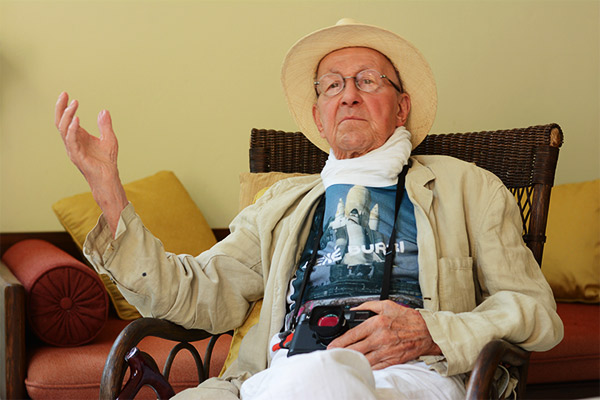 Rene Burri, Chiang Mai, 2014
Rene Burri, Chiang Mai, 2014
I was a little bit concerned prior to meeting one of the world’s most renowned photographers, the man behind the iconic Che Guevara smoking cigar shot, that he might roll his eyes at the mention of Che, or his old friend Pablo Picasso (it won’t be the first time he’s told stories about 20th century icons).
My few concerns quickly departed on meeting the man. Burri is an emphatic story-teller, he enjoys regaling his crowd; he is eloquent, affable, amusing, and he made sure we were on first name terms before the interview commenced. Wrapped from head to toe in white and beige he had the look of the man from Panama: suave, adjusted and at home in the tropics under the mid-afternoon sun.
His twenty year old son, the last child of five, starts recording our interview. When his 80 year old father gives up the ghost the next two hours will be a “living record” (Burri describes photography this way during our interview) of his father. There are about 10 other onlookers, and three or four people videoing our interview; not my ideal vis-a-vis type of interview, taking down someone’s 80-year hour-long history in a crowd of people, but Burri helps cushion the blow of invasive eyes by creating an intimate atmosphere within a now public space. He’s easy to interview, though at times he lets you know that he won’t tolerate silly questions, and occasionally he tests me, and the group of journalists on the sidelines, on world political history, his work, the themes, the names, what they did, how lived, and died. He tells us he once threw an interviewer out after he was asked a stupid question concerning his time spent with Che Guevara.
Burri usually takes one question and turns it into nine answers, all of which span many years and take place all around the world. He tells me, smiling knowingly (he is after all a journalist), that I’ll have to get back to my office and “sought through the spaghetti” of our conversation.
“I got out of the Paris cold last Wednesday,” he says, and he came here to Chiang Mai, the Dhara Dhevio hotel, that is holding his exhibition. If you walk around the palatial grounds of the hotel you’ll bump into pictures of Picasso toting a firearm, a shifty president Nixon, Che Guevara staring obliquely out of the corner of his eyes, his mouth confidently braced around a fat cigar.
In Lausanne, Switzerland, Burri knows a Thai/Swiss designer, and that’s how he came to hold an exhibition in Chiang Mai.
“This place is magic,” he says of the Dhara Dhevi, “almost too perfect”, and he compares it to a landscape created for a Disney production. It’s his first time in the northern capital. An “absolutely wonderful” place he tells me.
“In 1961 I was in Koh Samui. There was nothing there,” he says, and explains that his story on “paradise” consisted mostly of photographing monkeys throwing coconuts around. More than 50 years on, he’s enjoying his first stint in the north, regaling a crowd who weren’t even born when Burri was banging on Pablo Picasso’s studio door trying to get him to submit into doing a story.
“I wanted to see some giants of the 20th Century,” he says. Names on that list included Che Guevara, Pablo Picasso, and Alberto Giacometti. “It took several years to get to them,” he says, and tells us that a good photographer must be endowed with perseverance.
Undoubtedly it’s his now iconic shot of Guevara with a cigar that Burri is most known for, and perhaps his men on roof shot of Sao Paulo.
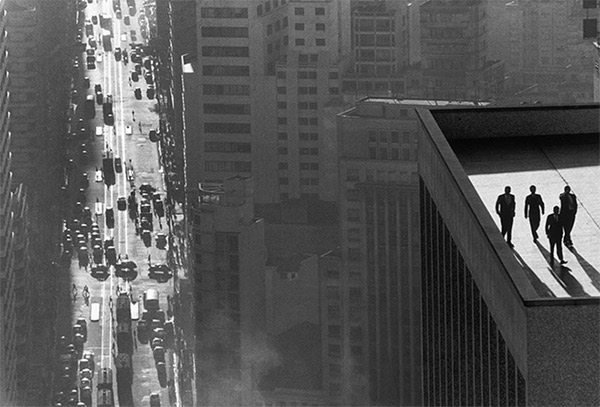 Rooftop, Sao Paulo, 1960
Rooftop, Sao Paulo, 1960
He does less than roll his eyes when I mention Che Guevara. He tells me the extended version of the story.
A US magazine got the go ahead to do the story in Cuba, and Burri was the man chosen for the assignment, working at the time with Magnum Photos. He’d worked in Cuba a few years earlier, and things were made easier due to the Swiss not needing a visa to enter the country at that time. Guevara had earlier told US reporter Laura Bergquist when he was with Fidel Castro at the United Nations in New York, denouncing the United States on their sponsored invasion of Cuba, that he would do an interview. But under one condition, says Burri, “as long as the Pentagon and CIA allowed them,” and it wasn’t long, Burri adds, that “they got the green light.” The interview would appear in Look magazine, a magazine that focused mainly on photography that ran from 1937-71.
Burri got the call and was told he was going to Cuba.
“The table was ready for New Year’s Eve, and I had to pack. My wife and children cried.” He left his sobbing family and took an empty train and arrived in Prague – the other side, he says, of the Iron Curtain – on New Year’s Eve. From there he took a Russian Tupolev into Cuba.
“It was January 1st, the celebration. A ceremony in Revolution Sqaure. I drove in, and tanks came out from left and right. I met the lady [Bergquist]. A week later I was in Che’s office on the 8th floor…I came in. It was dark almost, the blinds were drawn. He spoke French, I spoke a little Spanish, so I said, ‘Ernesto, or Che Guevara’… I don’t remember… ‘Can I open the blinds’… he just grumbled and said, ‘No.’ I said, ‘Well it’s your face, not mine.’”
”For almost three hours, Burri says, the interviewer and interviewee were involved in a battle: The Communists against The Capitalist. “She had to get some information,” Burri says, referencing a time in which the world had come close to self-destruction.
“I danced around the two of them getting at each other’s throats. It is the best thing that can to happen to a photographer,” and he describes how Guevera was serious, yet at the same time enjoying “making fun of the world”…Don’t take yourself too seriously is Burri’s follow-up remark to those of us sitting around him.
“I had 300/400 images,” Burri explains. He had no idea the cigar shot, a shot Burri was not too thrilled about later being cropped, would become an iconic image of the 20th century.
“The famous of Che became famous throughout history. In the Paris movement of ’68 they put it on the banner” says Burri. “If I’d been paid a Euro for every time that image was used I’d be rich, I could retire.” He breaks into laughter. He then takes a glass of water, drinks some, and then empties the rest on the floor, for what reason I am not sure.
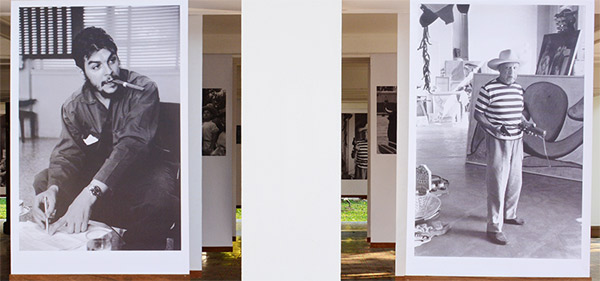 Exhibition at the Dhara Dhevi: Che Guevara and Pablo Picasso
Exhibition at the Dhara Dhevi: Che Guevara and Pablo Picasso
Two of three pictures make a photographer famous,” he says, and explains that for him it was probably Che, Picasso, but also a shot he took in Rio de Janeiro.
“You need three perfect moments…three perfect pictures.” This is no easy thing, he says, “immaculate conception doesn’t exist”, and so you have to react quickly, he says, you must pick the perfect moment to snap.
Getting the right shot also requires a stubbornness that borders on brazen, says Burri. To get Picasso he had to hitchhike to Paris from Switzerland, more than once. “I knocked on the door of his studio every day. I knew he was in there.” But Picasso wouldn’t answer, and so Burri had to hitchhike back home.
He finally found an open door in 1957. And after his first day with Picasso he photographed him on many more occasions. The two formed a friendship that lasted years.
“He was so generous,” says Burri, “I couldn’t believe his generosity.” He explains that in the early days Picasso could “make a painting like a photo,” but then with the inception of advanced photography, Picasso realized that he had to paint differently.
Later Picasso became world famous for his Cubism, but Renee tells us that, “Fame meant nothing to him” and he adds, concerning the money, “He wasn’t interested in business.” Burri seems to feel the same way about money, fame, the big names. “I was around Kings, queens, millionaires,” and he intimates that he never lost the common touch, as for Che Guevara, his big shot, he says, “I soon forgot about Che Guevara…famous means nothing.”
In a profession that he admits never paid well, and probably never will for any of the young generation embarking on a creative career, he says his mother’s response to his chosen vocation wasn’t in the beginning one of joy. Until she saw his photographs…and since those early days Burri has been supremely busy, too busy, he says. His Leica, a camera whose merits he extols at various points in the interview, is hanging from his neck during the interview. He photographs me at one point as I ask him a question. He can’t seem to stop himself.
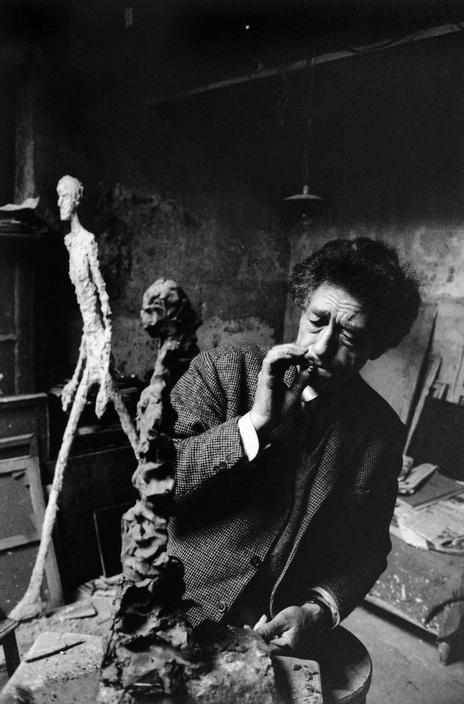 Alberto Giacometti, 1960
Alberto Giacometti, 1960
With, or without, light, he says, in response to my almost silly question about his modus operandi for taking shots. Of course, in a 50-odd year career, he’s tried everything. But at least we get another story. This one’s about LIGHT, or the absence of:
“It was a murderous night in New York,” he says, explaining that New York had experienced a massive black out. Burri took advantage of the electrical lapse and shot all night in the dark. A year later he tells us there are a lot of new babies in New York – “people got back to the essentials” – and Burri’s book of photography called ‘Blackout’.
“Art is beautiful, but it’s a tough business,” he says. “There’s no money, but there’s satisfaction.” Does he miss the old days, before digital, before you could find an artist just by joining his fan-page on Facebook?
“It’s absolutely fantastic,” he says of the new digital age, and the fact that an entire generation is trigger happy. Photography is the only medium, he says, “that can fix a moment that never comes back.”
“Thanks to photography we have a kind of drawing, painting, a living record of how things happen, good or bad,” he tells us hopefully, and says, “I believe in this.”
Although he’s not keen on the new-age phenomena of computerized post-production: “You don’t alter images using Photoshop…there should be a certain honesty.”
He means that the artist’s curiosity far exceeds, in terms of capturing beauty or moments of truth, the contrivances of the machines we now use. It’s about finding the perfect moment. And in spite of the fact that many of his moments have been being taken up by warlords, crooked politicians, or crouching in cities where men are routinely murdered, he tells us, as if offering advice to us young protégés, “I still believe in humanity.” And he makes it clear that he still believes in photography, with or without the tricks, to capture the vicissitudes of human behavior and social phenomenon.
His knees and feet are barely holding up these days. He walks with cane. He points to his feet, “If you’re not in good shape, you can’t work.” But he has more book projects on the go, to add to his 20-odd books already on the shelves.
I could go on, and I’m sure there are a lot more stories he’d like to tell, but some guys making a documentary film are whispering next to me asking if I can wrap up the interview. Fair enough, some things may have to be repeated, and the second time is never as good as the first.
Do you have everything you want? he says, or something to that effect. I’d put my pad down.
No, actually, not really.
So the documentary had to wait a while longer. I imagine Burri would have talked well into the night if we’d had the opportunity, and I’d have been grateful to relive the 50s, 60s and 70s with him, to talk about Khrushchev’s Soviet Union, or those dark fissures that had formed in the eternally unhappy face of Alberto Giacometti.
A YouTube video of the extended version of the story of Burri’s day with Che Guevara is here.
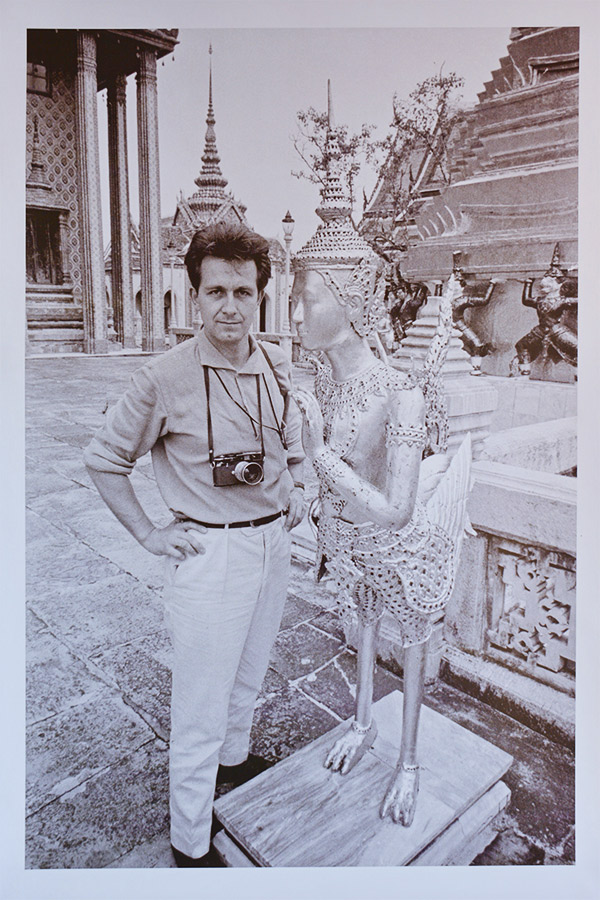 Rene Burri, Bangkok, 1961
Rene Burri, Bangkok, 1961